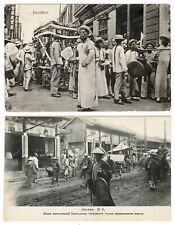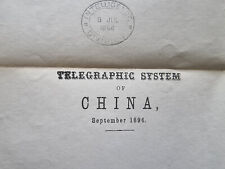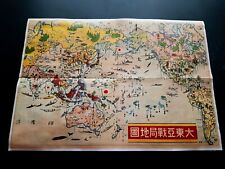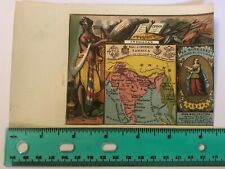|

On eBay Now...
china asia map beijing military hong kong shanghai telepgraphic map rare For Sale

When you click on links to various merchants on this site and make a purchase, this can result in this site earning a commission. Affiliate programs and affiliations include, but are not limited to, the eBay Partner Network.

china asia map beijing military hong kong shanghai telepgraphic map rare:
$1919.63
a very rare possibly unique map dated 1894 executed by the british military intelligence quarter masters general department, based in india, depicting the telepgraphic system of china 1894
map measures 24x20 inches map shows a few signs of age with two slight pinholes at the folds
only a small amount of militaty intelligence material for this era can be found in the british library as works were demed confidential an usually destroyed ..i have started and put a buy it now at what i think is a fair price based on rarety and subject matter
an extract taken from Ariane Knuesel work on britsh diplomacy and the telegraph in 19th century china, published by taylor francis group
Western powers like Britain and France wanted to expand trade and, therefore, pressured China in the 1860s to accept the telegraphso that trade information could be sent quicker. The telegraph was alsothought to facilitate foreign investment in railways and coalmines inChina. However, Chinese officials rejected the telegraph arguing that itwent against the geomantic principles of Fengshui ( ) and destroyedgraves, which was believed to have disastrous effects. The Chinese gov-ernment also feared that once cables linking treaty ports were established,demands to construct further lines would be made. Another problem wasthat foreigners in China were extremely unpopular. Thus, it was verylikely that telegraph lines would be vandalized for which the Chinesegovernment would be blamed and have to pay indemnities. On the whole,the Qing government saw foreign telegraph lines in China as a seriousthreat to Chinese sovereignty since they undermined the power ofChinese officials (e.g., authority and knowledge or information) andallowed the foreigners to break out of the treaty ports to which they haduntil then been confined.55Nevertheless, the China Submarine Telegraph Company was foundedin 1869 by the British businessman John Pender. In 1873 it merged withother companies to form the Eastern Extension, Australasia and ChinaTelegraph Company Ltd. Another Company with interest in China wasThe Great Northern Telegraph Company. It was founded by C.F. Tiegten in1869.56 While the Chinese government rejected foreign plans to link thetreaty ports with telegraph lines on land, it allowed in 1870 the constructionof submarine cables provided that they ended outside of the ports.57 Yet,ignoring these rules, the Great Northern laid a cable from Hong Kong toShanghai without the permission of the Chinese government in 1871. TheGreat Northern and the China Submarine Company co-operated on thisline and further agreed that the Great Northern could build cables north ofShanghai, while the territory south of Hong Kong belonged to the ChinaSubmarine Company. The same year, the China Submarine Companyconnected Hong Kong to Singapore. From there a cable went to Indiawhich was already linked to Europe. Thus, by 1871 China could bereached by telegraph from Europe.58 In 1873 the Great Northern built aline which linked Shanghai to Xiamen, a center for tea trade, again with-out formal consent of Chinese officials. As a result, the Qing governmentordered telegraph offices and telegraph posts to be torn down
Even though most Chinese rejected the telegraph, there were someChinese businessmen who advocated its use. They argued that China 524 Ariane Knueselneeded the telegraph in order to establish a modern economy and a stronggovernment.60 From 1861 to 1894, officials and scholars of the self-strengthening movement (ziqiang yundong ), especially those whobelonged to the yangwu ( ) movement, advocated the use of Westerntechnology and the import of military material like weapons and steam-ships in order to modernize the Chinese military forces. In an effort tomodernize Chinese defence industry, Chinese-owned enterprises likemachine factories, arsenals, shipyards, mines, railroads, etc.


China 2 old Chinese Postcards Cyrillic Text North China $42.00

china asia map beijing military hong kong shanghai telepgraphic map rare $1919.63

Asia City Shanghai China ~ New Image Card 4"x6" 8137.2 $3.75

RARE 1950 Rand McNally Official War Map of Korea Soviet China Asia Cosmo 775 $12.00
![[CHINA-XINHAI REVOLUTION] Album with 74 Original Photos. Ca. 1910s picture](/store/img/g/MuEAAOSwNGpmhPtG/s-l225/-CHINA-XINHAI-REVOLUTION-Album-with-74-Original-Ph.jpg)
[CHINA-XINHAI REVOLUTION] Album with 74 Original Photos. Ca. 1910s $2250.00

East Asia Country Flag Novelty Car License Plate $17.89

1942 WW2 JAPAN PACIFIC WAR MAP CHINA ASIA NAVY WARSHIP FLAG PROPAGANDA POSTER $24.99

01 LA HONRADEZ CIGARETTE PACK LABEL WRAPPER: INDIA CHINA ASIA ASIAN CUBA 1860's $99.95
|